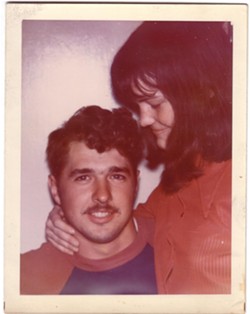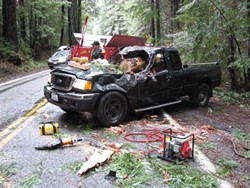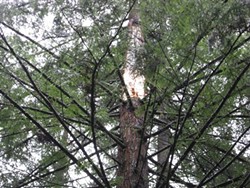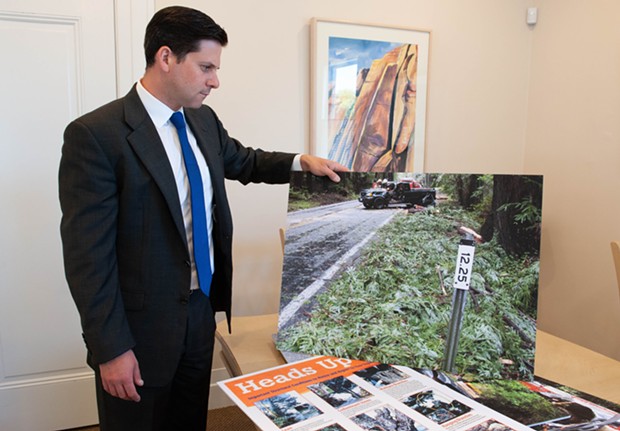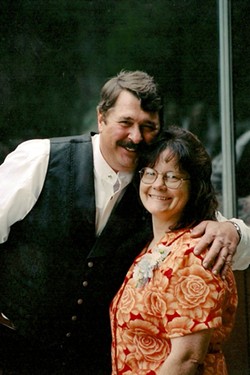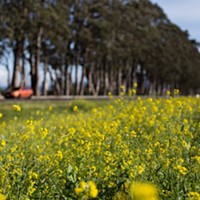'Absolutely Preventable'
A family devastated by a fatal tree fall fights to stop it from happening again
By Kimberly Wear [email protected] @kimberly_wear[
{
"name": "Top Stories Video Pair",
"insertPoint": "7",
"component": "17087298",
"parentWrapperClass": "fdn-ads-inline-content-block",
"requiredCountToDisplay": "1"
}
]
JoAnn Duey was still in high school when she first saw the man who would become her husband walk inside the small Carlotta grocery her parents owned.
Soon Ted Duey was a frequent visitor, driving up in his red Mustang and drinking cup after cup of coffee at the store's counter so he could spend time with her as she worked. He was, JoAnn Duey says, quite simply, a gentleman.
"He was my first date, he was my first love," she says in a soft voice during a recent interview, while sitting on a couch beside her eldest son Clint Duey. "He was the love of my life, and Ted and I were very young. I was only 19 years old when we married."
The two essentially grew up together after their wedding in the summer of 1973, JoAnn Duey says. They became inseparable.
Over the next 38 years, the Dueys built a contented life together, raising three children — Clint was born in 1975, followed three years later by twins Deakon and Sabrina — on their rural ranch 30 miles down State Route 36 in a homestead Ted Duey built with his own hands.
In 1986, the couple took over the store where they met, working side by side every day for two decades, carrying on a tradition started by JoAnn Duey's family, whose ties to the area date back to the turn of the last century.
First opened by her great aunt and uncle, and later run by her parents, the sign outside of their small community's mainstay changed from "John and Mabel's" to "Martin and Shirley's" and then "Ted and JoAnn's."
While juggling the demands of running a ranch and the store made for a busy schedule, the Duey children grew up knowing their parents would always make time to support them.
"It was very important for us to be there at every event for the kids," JoAnn Duey says. "He was a supportive man. A family man. And a Cowboys fan. He loved his kids so much."
Clint Duey, now the principal of Fortuna High School, says he learned a lot from his father — from his fierce commitment to be an integral part of his children's lives to the way he carried himself. Standing 6 feet, 2 inches tall with a physique built by hard work, he says his father could have exuded a sense of intimidation but "never used that in his parenting."
Instead, his father led by example as a person the community knew it could depend on, whether it was behind the counter of the store, helping a neighbor mill wood or coaching youth sports from the sidelines.
"He was a phenomenal person in that way," Clint Duey says.
As the years passed, Clint Duey and his siblings started families of their own and a new generation began looking up in the stands to find Ted and JoAnn Duey cheering them on.
Then, on March 31, 2012, the unthinkable happened.
Ted and JoAnn Duey were heading down the winding, tree-lined curves of State Route 36, returning home to their ranch after spending the rain-soaked day at their grandson's wrestling match and visiting family.
It was a drive the couple knew well, having passed through this section of the rural highway by Swimmers Delight every day on their way to and from work.
Suddenly, the massive trunk of a roadside redwood tree broke off 75 feet up and came slamming through the driver's side windshield of their truck.
"That day, you feel so helpless," JoAnn Duey says in a quivering voice as her eyes well with tears. "Watching Ted ge
t crushed, I couldn't help him. I couldn't do anything. ... I couldn't help the love of my life."Ted Duey was 60.
Seven years later, the family is still reeling. They also believe what happened on that March day could have been prevented had Caltrans' employees followed the agency's own safety guidelines, something the Dueys fear the agency still isn't doing.
On the eve of trial earlier this year, Caltrans settled the Dueys' wrongful death and dangerous condition of public property lawsuit, agreeing to pay the family $2 million with no admission of liability.
Attorney Ben Mainzer, who represented JoAnn and Clint Duey, says his research in the case and the testimony of Caltrans employees and experts shows there was a "top-down failure to supervise and, from the bottom-up, there was failure to train or be trained."
"Caltrans had opportunity after opportunity to do that right thing and, if they had, Ted would still be alive. It was absolutely preventable," he says. "This was absolutely preventable and that's what is so tragic and that is what's so hard for Clint and JoAnn and all of the Dueys. There was no reason for Ted to die."
While even healthy trees can topple, there are certain warning signs that indicate if one is prone to fail, which Caltrans employees — especially boots-on-the ground crews like tree trimmers —are supposed to be trained to recognize and report.
Those defects include when a trunk splits and begins growing as two or more equal-sized parts — called a codominant stem or leader — which are susceptible to weakening and breaking off, like the one that crushed Ted Duey.
The massive trunk section was later deemed an "extreme risk" due to an estimated 12-foot-long crack with an 8-inch gap that would have been wide enough to let sunlight shine through. With one expert — the state's arborist — describing the fissure as several years old and "very, very difficult not to observe."
Yet, no one did, Mainzer says, despite numerous chances. None of what needed to happen was difficult, he says, it was simply Caltrans policy.
A little more than a year before the accident, in November of 2010, Caltrans set new guidelines to standardize how tree inspections are done across California, citing at the time an increase in injuries and deaths involving trees along the state's roadways.
One of the conditions inspectors are supposed to identify in the surveys are codominant stems, with Caltrans policy requiring those trees be red flagged for further inspection.
Crews were on the section where the lethal redwood still sits some 3 to 4 feet from the road at least four times in as many years leading up to the accident, including to conduct tree trimming in the area just six months before Ted Duey was killed.
That work alone should have triggered what's known as a level 2 inspection that would include walking the site to scan for potential hazards and more carefully inspect trees with noted defects, like codominant stems. But crew members testified in pretrial depositions that they didn't regularly report codominant stems nor were they directly told to do so.
Just one month before the fatal crash, District 1's tree maintenance supervisor Darin Sullivan conducted an annual tree survey on State Route 36. But there's no record he ever got out of the car at the crash site despite 11 tree failures between 2004 and 2012 along a short stretch between milepost markers 11.3 to 13.5, the highest rate anywhere on the highway.
Ted Duey died at milepost marker 12.25.
Instead, Sullivan testified he likely drove by at an estimated 25 mph, somehow looking out the window for the tell-tale warning signs — some lurking several stories high in the woods — while simultaneously keeping his eye on one of the region's most dangerous roads.
When asked if Caltrans records indicated "a substantial number of other tree failures" in the stretch, Sullivan answered "true" during his deposition while also stating he thought the area around milepost 12.25 was too dangerous to canvass on foot because there's not a large enough shoulder.
In fact, Sullivan did not red flag a single tree as needing a closer look along the entire 45-mile stretch of State Route 36 during the 2011 and 2012 inspections, even though Caltrans had just instituted more rigorous standards.
How the tree was missed despite the opportunities and the obvious warning signs is inconceivable, Mainzer says.
"That should be frightening to anyone who goes on roads that have trees in this area," he says. "It certainly scares me."
The lawsuit, Mainzer says, was about making sure what happened to the Dueys never happened to another family by spurring Caltrans to follow the very safety procedures already on its books.
"Our hope was that by obtaining the settlement, we would — in essence — shine a light on what Caltrans was not doing," Mainzer says.
Caltrans, however, maintains proper protocol was followed and the tree that killed Ted Duey would have been difficult to spot no matter how well the annual inspection had been conducted, describing the terrain as a "densely forested area on private property not owned by Caltrans."
"The records reflect that Caltrans conducted annual tree inspections but did not identify the defect in the subject tree, which caused it to fail," agency spokesperson Myles Cochrane wrote in an email to the Journal, adding the split occurred at about the height of a six-story building.
Tom Fitzgerald, deputy director of maintenance and operations for Caltrans District 1, which includes Humboldt County, says the basic idea of the annual inspections is to "try to identify any hazard tree that can be seen from the road that may be a danger to travelers on the roadway."
Put simply, a Caltrans employee who has been certified in tree risk assessment basically drives up and down all of the district's roads while conducting a so-called "windshield survey" for dead or dying trees, trees that lean, hanging branches and codominant stems, among other potential dangers that would trigger an on-the-ground inspection.
But, Fitzgerald says, identifying those hazardous conditions is a constant job that depends on members of the public, landowners and Caltrans crews out on day-to-day assignments to report potential problems. In the end, he says, there's simply no way to inspect every tree.
"We're always preparing for winter, we're always looking for anything that might be an immediate hazard," Fitzgerald says. "It's year-round. The annual tree inspection is just one way to make sure everything gets looked at but it's certainly not the only time it gets looked at."
Fitzgerald says tree maintenance crews are trained to watch for codominant stems but the defect isn't necessarily an immediate concern, although Caltrans denotes the defect as one with "a relatively high potential for failure" on the agency's training poster titled "Heads Up."
"Codominant stems are a condition so common in District 1 that to report each one on that basis alone is impractical," he says. "If the codominant condition was noted, our crews would know to look for other signs that the tree was hazardous to workers or the traveling public."
And, Fitzgerald says, Caltrans maintains that regardless of how well a drive-by survey with occasional stops — or a level 1 inspection — was done, the inspector wouldn't "have necessarily ever seen that defect in the tree," describing the break as occurring in an area obscured by branches and other foliage,
"That is not to say that we just need to accept that tree failures will cause injuries to users on our highways," Fitzgerald says. "Caltrans safety goal for our highway workers and users of our transportation system is zero fatalities and we will continue to relentlessly pursue that goal."
Fitzgerald stresses that the agency has reflected on the incident and what — if anything — it could have done to prevent what happened.
"We talked about if we'd gone slower or had binoculars and, in the case of the tree, without a different vantage point and without calling a level 2 survey, we could not have identified that defect," he says.
That's exactly the point, according to Mainzer.
"What is truly tragic is that all Caltrans had to do was follow policy and procedure," he says. "If they had done nothing more than that, the defect in the tree would have been observed and Theodore wouldn't have died."
Mainzer says his investigation determined that there were 41 tree failures in District 1 on State Route 36 from 2004 to 2012 and a 5 percent segment of the roadway, which includes the area near Swimmers Delight, had at least four of those incidents between 2007 and 2011.
"Any one of those failures could have led to another death," Mainzer says, adding that all Caltrans had to do was "go to the hot spot and look, and they would have seen the problem."
"There was no other section of State Route 36 that had a higher level of tree failure," he says.
Mainzer points to Caltrans' 2010 directive, which cites the agency's tree risk assessment training guide as a primer for "tree risk assessment strategies, descriptions, identifications and signs of tree conditions that may predispose trees to structural failure" and states that the directive was now "an addition to tree inspection requirements."
Included in the module is a section that states a "more frequent inspection program should be established in high use areas or in areas with a history of tree disease or damage. Trees that are subject to disease or damage may require more frequent inspections. By ongoing visual surveillance, the tree manager can detect, prioritize and schedule abatement treatments."
It also notes that, "some conditions are obvious while others require detailed inspection and evaluation" and "a systematic, thorough inspection of the entire tree and area around the plant may be necessary to detect diseased or weakened conditions."
But, according to Sullivan's testimony, that "probably" didn't happen on the section of State Route 36 where the higher level of failures occurred.
"This wasn't a situation where we're saying to Caltrans, 'You need to change your policy, you need to change your procedure,'" Mainzer says. "What we're saying is, 'Just do what you said you were going to do.'"
The recorded annual cost of inspecting the 45- mile stretch of State Route 36 located in District 1 has stayed relatively steady at around $500 in the years before the crash, immediately after the crash and last year, according to Caltrans documents provided to the Journal and discussed during the depositions.
This basically means the inspector — Sullivan continues to do the surveys although he has since been promoted to a district supervisor position — is still driving the roadway alone while making occasional stops, even seven years after Ted Duey's death.
"Maybe that's the most shocking aspect of this all ... Caltrans seems to be doing what it has done before, which is inadequate tree inspections, which endangers everyone driving on roads in Humboldt County," Mainzer says.
Fitzgerald says he appreciates the Duey family's perspective but there is simply no way Caltrans can inspect every tree that could impact the 2,000 shoulder miles under District 1's domain and keep on track with all the other work necessary to keep roadways safe.
"If the position is that we could do more, I don't think that's something we could dispute," he says. "But did we do what was prudent in order to make a responsible effort to identify (trees) and reduce the risk (of failure)? ... We would argue we did do that."
He says that perhaps in a world with "endless resources" a more comprehensive review might be possible but that's not the world in which Caltrans workers operate. "I guess there are always ways to make it safer and be more cautious, but everything has its cost."
In the wake of the settlement, Caltrans District 1 has reviewed the inspection procedure and is looking at some changes. According to Fitzgerald, those include increased communication with highway-adjacent landowners and additional support for the inspector.
"The biggest change that we are considering is making more use of the policy that we have of notifying adjacent property owners of anything we see that we think they might want to look at more closely," he says.
In this case, the landowner — Humboldt Redwood Co. — was dismissed from the Dueys' lawsuit with the court finding HRC "had no duty, as a matter of law, to inspect the area adjacent to Highway 36 and remove trees at risk of falling onto Highway 36, as the State of California was performing that inspection and removal."
Another change Caltrans District 1 is considering— which is already done in other regions — is providing a "shadow car" or possible traffic controls such as lane closures in certain areas that need to be evaluated at a slower speed "so we could do so without a risk to an inspector."
Along those same lines, Fitzgerald says Caltrans District 1 is also looking at providing an additional driver for some roadway sections that are more heavily forested "so the inspector is a passenger and can be solely focused on spotting trees."
Sitting together on a coach in Mainzer's Eureka law office, JoAnn Duey and her son emphasize that their lawsuit against Caltrans wasn't about the money but preventing another family from enduring the pain they are experiencing.
JoAnn Duey says her husband was not the kind of person who spent money on material things. His gifts were often handmade, like the heart he chain-sawed out of a tree stump for their anniversary one year.
"People need to be aware," she says.
JoAnn Duey says she still doesn't understand why this had to happen but she wants people to recognize the potential dangers that exist amid the trees along Humboldt County's roadways.
"What I went through and what we went through as a family, you don't understand," she says. "My heart aches. It has been seven years. I love my children so much and they've had to take care of their mom, and that is really hard."
Meanwhile, Clint Duey notes, the "tree that is the issue, that brought this all to light, the other top of the tree is sitting there seven years later."
Mainzer says working on the case has made him wary and when he's traveling State Route 36, he's looking up. "It's not a road I like to drive," he says.
Residents and travelers alike should be able to expect that Caltrans procedures are being followed, Mainzer says, adding he hopes the settlement will "shine a light" on what is happening.
"I've known the Dueys for years," Mainzer says. "I've known them since 2012. They are wonderful people, they are truly kind, generous, hardworking people. It's a terrible thing to happen to anyone but for this to happen to them, it's truly horrible."
"If what this case did was give JoAnn's family peace and shame Caltrans into making sure this doesn't happen to someone else's family, then what we did has a purpose," he says. "Caltrans can continue to claim it wasn't at fault, that it wasn't its tree or that nothing could have been done, but the state of California doesn't agree to settle cases for millions of dollars unless it recognizes it got caught in the wrong. That was clearly the case here."
But, in the end, there is nothing that can bring Ted Duey back, nothing that allows JoAnn Duey to once again hear his warm laugh, nothing that will return him to his seat at the Pinochle table or put him back in the stands at his grandchildren's sporting events.
"He was the glue to our family," JoAnn Duey says. "Our family is shattered. ... We were just trying to get home."
Editor's note: In the interest of full disclosure, it should be noted that Myles Cochrane, who is quoted in the above story, is the founder of Humboldt Last Week, with which the Journal has an ongoing promotional partnership.
Kimberly Wear is the assistant editor at the Journal. Reach her at 442-1400, extension 323, or [email protected]. Follow her on Twitter @kimberly_wear.
Comments
Showing 1-1 of 1
more from the author
-
Dust to Dust
The green burial movement looks to set down roots in Humboldt County
- Apr 11, 2024
-
Our Last Best Chance
- Apr 11, 2024
-
Judge Rules Arcata Can't Put Earth Flag on Top
- Apr 5, 2024
- More »
Latest in News
Readers also liked…
-
Through Mark Larson's Lens
A local photographer's favorite images of 2022 in Humboldt
- Jan 5, 2023
-
'To Celebrate Our Sovereignty'
Yurok Tribe to host gathering honoring 'ultimate river warrior' on the anniversary of the U.S. Supreme Court ruling that changed everything
- Jun 8, 2023

